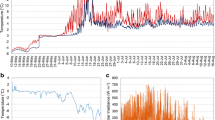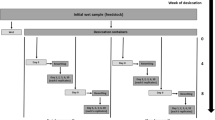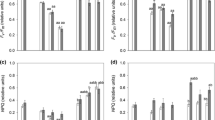Summary
The ability of cyanobacterial mats from Antarctic ponds and streams to recover from desiccation is described. Mats dominated by Nostoc dehydrated rapidly and were dry within 5 h of exposure. Nostoc mats recovered to pre-desiccation rates of photosynthesis and respiration within as little as 10 min of rewetting. Recovery of acetylene reduction activity was slower (>24 h). Phormidium dominated mats were less tolerant of desiccation, and recovery on rewetting from air-drying was not complete after 10 days. Viable diaspores were, however, found in Phormidium mats which had been exposed for 3 years. Partial hydration during aerial exposure improved the survival of Phormidium mats, but appeared to slow the recovery of Nostoc mats on subsequent rewetting.
Similar content being viewed by others

References
Becker EW (1982) Physiological studies on antarctic Prasiola crispa and Nostoc commune at low temperatures. Polar Biol 1:99–104
Coxson DS, Kershaw KA (1983) Nitrogenase activity during chinook snowmelt sequences by Nostoc commune in Stipa-Bouteloa grassland. Can J Microbiol 29:938–944
Davey MC (1989) The effects of freezing and desiccation on photosynthesis and survival of terrestrial antarctic algae and cyanobacteria. Polar Biol 10:29–36
Debenham F (1920) A new mode of transportation by ice: the raised marine muds of south Victoria Land (Antarctica). Quart J Geol Soc, London 75:51–76
De Winder B, Matthijs HCP, Mur LR (1989) The role of water retaining substrata on the phytosynthetic response of three drought tolerant phototrophic micro-organisms isolated from a terrestrial habitat. Arch Microbiol 152:458–462
Demmig-Adams B, Maguas C, Adams WA, Meyer A, Kilian E, Lange OL (1990) Effect of high light on the efficiency of photochemical energy conversion in a variety of lichen species with green and blue-green phycobionts. Planta 180:400–409
Du Bois JD, Kapustka LA (1983) Freeze-recovery physiology of nitrogenase activity in terrestrial Nostoc sp.colonies. Appl Environ Microbiol 46:773–778
Ellis-Evans JC, Walton DWH (1990) The process of colonization in antarctic terrestrial and freshwater ecosystems. Proc NIPR Symp Polar Biol 3:151–163
Ernst A, Chen TW, Böger P (1987) Carbohydrate formation in rewetted terrestrial cyanobacteria. Oecologia 72:574–576
Flett RJ, Hamilton RD, Campbell NER (1975) Aquatic acetylene-reduction techniques: solutions to several problems. Can J Microbiol 22:43–51
Garcia-Pichel F, Castenholz RW (1991) Characterization and biological implications of scytonemin, a cyanobacterial sheath pigment. J Phycol 27:395–409
Hawes I (1989) Filamentous green algae in freshwater streams on Signy Island, Antarctica. Hydrobiologia 172:1–18
Hawes I (1990) Effects of freezing and thawing on a species of Zygnema (Chlorophyta) from the antarctic. Phycologia 29:326–331
Hawes I, Brazier P (1991) Freshwater stream ecosystems of James Ross Island, Antarctica. Antarct Sci 3:265–271
Howard-Williams C, Pridmore RD, Downes MT, Vincent WF (1989) Microbial biomass, photosynthesis and chlorophyll a related pigments in the ponds of the McMurdo Ice Shelf, Antarctica. Antarct Sci 1:125–131
Howard-Williams C, Pridmore RD, Broady PA, Vincent WF (1990) Environmental and biological variability in the McMurdo Ice Shelf Ecosystem. In: Kerry KR, Hempel G (eds) Antarctic ecosystems ecological change and conservation. Springer, Berlin, pp 23–31
Jones K (1977) The effects of moisture on acetylene reduction by mats of blue-green algae in sub-tropical grassland. Ann Bot 41:801–806
Potts M, Bowmann MA (1985) Sensitivity of Nostoc commune UTEX 384 (Cyanobacteria) to water stress. Arch Microbiol 141:51–56
Potts M, Morrison NS (1986) Shifts in the intracellular ATP pools of immobilised Nostoc cells (Cyanobacteria) induced by water stress. Plant Soil 90:211–221
Scherer S, Ernst A, Chen T-W, Böger P (1984) Rewetting of drought-resistant blue-green algae: Time course of water uptake and reappearance of respiration, photosynthesis and nitrogen fixation. Oecologia 62:418–423
Schmidt S, Moskall W, De Mora SJD, Howard-Williams C, Vincent WF (1991) Limnological properties of antarctic ponds during winter freezing. Antarct Sci 3:379–388
Shephard KL (1987) Evaporation of water from the mucilage of a gelatinous algal community. Br Phycol J 22:181–185
Vincent WF (1988) Microbial ecosystems of Antarctica. Cambridge University Press, Cambridge (UK), 304 pp
Vincent WF, Howard-Williams C (1986) Antarctic stream ecosystems: physiological ecology of a blue-green algal epilithon. Freshw Biol 16:219–233
Wynn-Williams DD (1991) Aerobiology and colonization in Antarctica — the BIOTAS programme. Grana 30:380–393
Author information
Authors and Affiliations
Rights and permissions
About this article
Cite this article
Hawes, I., Howard-Williams, C. & Vincent, W.F. Desiccation and recovery of antarctic cyanobacterial mats. Polar Biol 12, 587–594 (1992). https://doi.org/10.1007/BF00236981
Received:
Accepted:
Issue Date:
DOI: https://doi.org/10.1007/BF00236981



